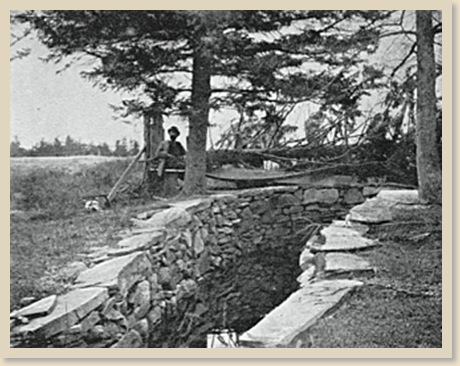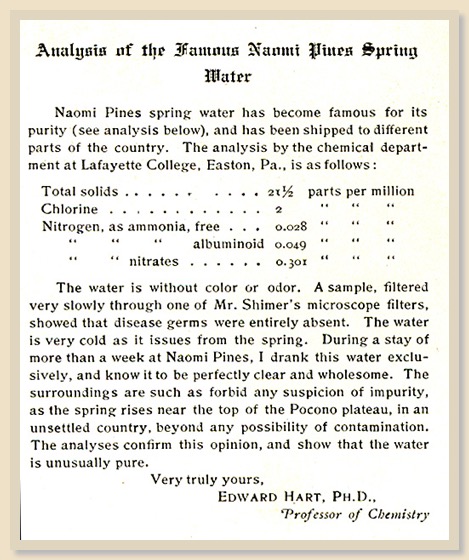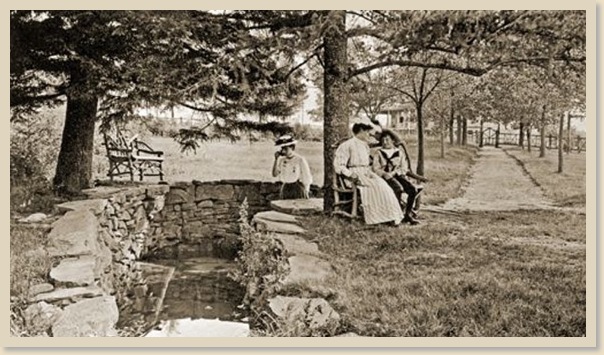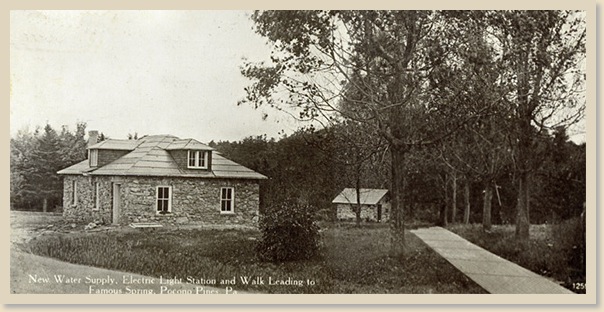
Prepared
By Fred Lehrer & Rick Bodenschatz
August 2012
The Naomi Pines spring, believed to be the oldest surviving structure in the vicinity of Pocono Pines, played an historic role in the development of the region. It had been neglected for decades, but was refurbished by Lake Naomi Club in 2011-2012. The stonework was in excellent condition, and the historic site is now an attractive “vest pocket park.”
Originally built to service nearby farmhouses with abundant water from artesian wells, the spring was probably constructed soon after the Civil War. The quality of its water was a selling point when the Naomi Pines House was built across the street in 1888, creating a tourist industry in Pocono Pines.
The spring is located off Route 940 in Pocono Pines, across Miller Drive from Van Gilder’s Jubilee Restaurant and just northeast of Miller’s Stone House. Its northern terminus is the spring house immediately adjacent to it.
History of the Naomi Pines Spring
The water in an artesian spring such as Naomi Pines flows up to the earth’s surface, a direction dictated by underground pressure rather than gravity. Originating in a contained underground aquifer, the water escapes through a crack in the aquifer’s upper rock cap. Not having flowed through a streambed, the water is uncontaminated, and has a degree of purity approaching that of the aquifer itself.
The location of the structure we now know as the Naomi Pines Spring was dictated by the point at which water was found emerging from the ground. The elaborate stonework created a reservoir of modest size at that strategic location, facilitating access by users.
The precise date of the spring’s construction is unknown. It is believed to date to the decades following the Civil War, when the locale was known as Tomkinsville. Farmhouses in the vicinity needed a source of pure drinking water, as did individuals engaged in the logging industry. While the earliest picture of the spring is from 1895, the sizes of trees immediately adjacent to the spring in that picture show that it was a mature site by then.
Indeed, when the Naomi Pines House was founded in 1888, pure water was an asset used to attract the tourist trade. A brochure from that year lured city dwellers with this colorful description:
“Several large springs are ... bubbling up from the earth at a temperature of 9 degrees above freezing. This spring is particularly noted for its medicinal properties. Oh, broken down constitutions, nervous people, dyspeptics, those afflicted ... come drink of this water and be cured!”
By June 1894 the Naomi Pines House published expert testimony from a satisfied guest. He was Edward Hart, Ph.D., and professor of chemistry at Lafayette College in Easton:
“… I drank this water exclusively and know it to be perfectly pure and wholesome.”

What prospective tourist, with or without a broken down constitution, could resist that pitch? The spring thus played an important role in the development of the region, sustaining early settlers and attracting later visitors. The pump house nearby distributed spring water throughout Pocono Pines well into the 20th century.

The Naomi Pines House used the 1906 photograph above for publicity purposes. A penny postcard identified the boy as Albert G. Clay, son of a professor at Yale University. The Clays were long-time summer residents of Pocono Lake Preserve. Young Albert became a Yale man, and then an architect in New York and Connecticut. He passed away in 1981 at the age of 83. While Albert had no children, research has revealed that direct descendants of his mother, seated next to him in the picture, are still around. Her grandson is an attorney residing in Annapolis, Md.

The Naomi Pines House also used the picture above, circa 1910, for publicity purposes. The spring is at the end of the short path at right, which commences at the arch. The scene is dated by the car, which appears to be either a White or Oakland touring car of that era.

The photo above shows the springhouse in the background, just to the north of the spring, showing with the recently completed pump house, later known as the Naomi Pines Water & Electric Company.

The Naomi Pines Water & Light Company building survives in excellent condition today. It supplied water to the hotels and cottages “up the hill” along Sullivan Trail. It also housed electrical generating equipment, supplying electricity to the same customers. (See story on the Naomi Pines Water & Light Company.)


Today the reclaimed Naomi Pines Spring is a charming and historic site, providing visitors with an oasis for relaxation and contemplation.
With the leadership of Fred Lehrer and the enthusiastic participation of members of the Lake Naomi Club, volunteers began clearing the overgrown and largely unknown site in the fall of 2011. The club did further cleanup, drainage, grading and landscaping in 2012. An interpretive sign was designed and donated by HATT members Holly & Fred Lehrer, and HATT donated two benches, which have been placed in the same locations as the benches in the 1906 photo.